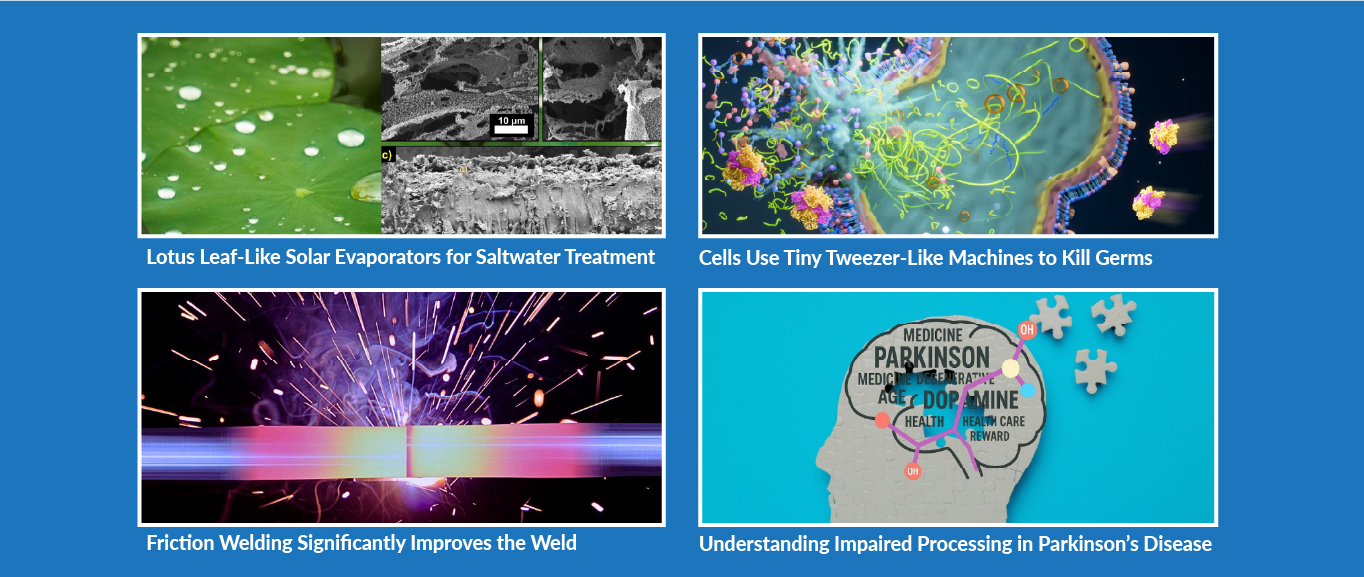1. Lotus Leaf-Like Solar Evaporators for Saltwater Treatment
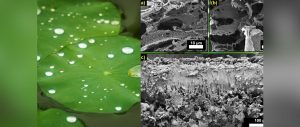
Lotus leaf. Inset: SEM images showing the top porous forest-like structures. (a) Surface morphology of Modified PES LIG, (b) features of PVDF silica LIG, (c) cross-sectional view of the entire evaporator
Source: Study
The following article was originally written by Mr. Arul Ganesh S S and published here.
A new hydrophobic graphene-based material developed by IITB scientists could support efforts to address fresh freshwater crisis
Freshwater scarcity is a significant issue in various parts of the world and is expected to intensify in the coming years. While water is abundant on Earth’s surface, only about 3% of it is freshwater, and even within that, less than 0.05% is easily accessible. Removing salt (desalination) from seawater and brackish water is seen as one of the solutions to address this problem, with researchers working towards developing more efficient and faster desalination techniques. However, brine (concentrated salt solution) from desalination is a big problem in landlocked places, and industries are looking for zero liquid discharge.
In one such attempt, researchers Prof. Swatantra Pratap Singh and Aiswarya C. L. from the Indian Institute of Technology, Bombay, have developed a new material that can facilitate water desalination. This material, which the researchers are calling the Dual-Sided Superhydrophobic Laser-Induced Graphene (DSLIG) Evaporator, addresses multiple shortcomings of earlier evaporators and has the potential for large-scale applications.
Solar energy-based desalination methods are considered desirable due to their reduced carbon footprint. However, factors such as fluctuations in intensity and availability of sunlight and reduced rates of absorption of light greatly affect the efficiency and consistency of solar energy-based desalination techniques. In recent years, interfacial evaporation systems have emerged as a promising approach. The key component of these systems is an evaporator made from materials that can absorb solar energy and heat up. The evaporator, placed on the surface of the water, focuses solar heat on a thin layer of water at the evaporator’s surface rather than heating the entire volume. This localized heating minimizes heat loss and enhances the efficiency of the desalination process.
However, despite this advantage, the problems with traditional solar desalination techniques do affect interfacial evaporators as well. As Prof. Singh explains, “Fluctuations in solar radiation cause temperature variations on the evaporator’s surface. On cloudy days, the performance of the interfacial system is halted due to the lack of solar energy. Additionally, the variation in solar radiation during the day affects the evaporation process, with evaporation rates typically peaking around 2 pm when solar intensity is highest.”
Another major challenge with interfacial evaporation systems is the deposition of salt crystals on the surface of the evaporators. Salt deposition on the surface prevents water from coming in contact with the evaporator, and consequently, its efficiency diminishes over time.
Prof. Singh and Aiswarya’s research aims to address both of these issues. In addition to solar heating, DSLIG evaporator can also be heated using electricity (known as Joule heating). By combining solar and electric heating, the material is protected from fluctuations in the availability of sunlight. When there is less or no sunlight, electricity can be used to heat the evaporator and maintain similar temperatures, ensuring consistent performance.
Additionally, DSLIG has a superhydrophobic property, meaning it repels water like lotus leaves. Owing to the characteristics of their surfaces, superhydrophobic materials reduce the contact area between water droplets and the material surface, making droplets roll over them instead of wetting. In desalination applications, the superhydrophobic nature of DSLIG helps prevent salt dissolved in water from sticking to the evaporator surface, thus maintaining efficiency over time. “The primary goal of our work was to create a superhydrophobic surface, exhibiting the lotus effect, capable of functioning with both solar and Joule heating,” says Prof. Singh.
The researchers fabricated DSLIG by coating a layer of a polymer called polyvinylidene fluoride (PVDF) on one side of a thin layer of another polymer LIG, poly(ether sulfone) (PES). Graphene was then engraved on the PVDF polymer side of the material using laser-based engraving technology. The material derives its name from the fact that it has two distinct sides formed by the two polymers and the fabrication technique used. PES doesn’t repel water, but it is essential to prevent the evaporator from breaking easily.
Prof. Singh explains, “If only PES were used, the final surface would get wet on both sides. However, using PVDF resulted in hydrophobicity on both surfaces. The use of PES as a substrate ensured mechanical stability, while the PVDF layer contributed to the hydrophobic characteristics necessary for efficient evaporation processes.”
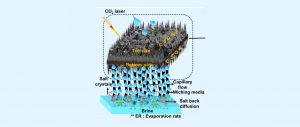
Graphical representation of DSLIG. Image Credits: Authors of the study
Laboratory tests show that DSLIG not only exhibits lotus leaf-like behavior, preventing salt deposition and excellent efficiency for desalination under both electric and solar heating, but is also very effective in treating extremely concentrated salt solutions. This makes it an ideal candidate for treating salt water discharges from other desalination outlets as well as industrial wastewater. The researchers have also demonstrated that the performance of DSLIG improves when multiple evaporators are stacked on top of each other.
While the low carbon footprint, low toxicity, and cost-effectiveness make DSLIG a potential candidate for large-scale sustainable desalination applications and the treatment of industrial wastewater, Prof. Singh notes that further field testing is required before such large-scale applications can be made. One of the major hurdles the team faces in ensuring and testing the industrial readiness of this technology is a lack of funding. In the meantime, Prof. Singh and his group are looking forward to developing more such superhydrophobic materials that can simultaneously utilise both solar and electric energy with even greater efficiency.
**********************************************************
The original academic article titled Dual-Sided Superhydrophobic Laser-Induced Graphene Evaporator for Efficient Desalination and Brine Treatment under High Salinity was written by IIT Bombay’s researchers and published in the journal ACS Applied Materials & Interfaces
Vol 17/Issue 3.
The original paper can be found here.
2. Cells Use Tiny Tweezer-Like Machines to Kill Germs
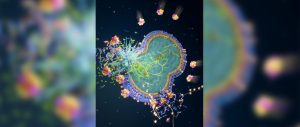
The following article was originally written by Mr. Anirban Banerjee and Mr. Sourav Ghosh. and published here.
Ever wondered how we stay healthy while navigating our daily life; rushing to work or school, braving harsh weather and pollution, or grabbing a quick bite from a nameless street vendor, all while being exposed to millions of germs? The good news is that there is a silent war raging inside us, and most of the time, we emerge victorious, thanks to the incredible power of our immune system.
A fascinating study from IIT Bombay led by Prof. Anirban Banerjee and his group discovered a new arsenal of this immune system. Their recent study, published in the journal Nature Microbiology highlights that VCP/p97, a host protein, works like an elite special operation unit which detects the threats and neutralizes them before they can cause harm. When bacteria attack our cells and steal nutrients from them, our cells recognize this as a hazard and tag them as a ‘Red Flag’ using a special protein called “Ubiquitin”. That’s when VCP gets to work. These tiny plucking machines targets these flagged bacteria and plucks out hair like projections from bacterial membrane (surface proteins) to tear them apart. It’s analogous to a swarm of piranhas, surrounding its prey, eating them piece by piece. This prevents the germs from spreading or making us sick.
The work was primarily done by Mr. Sourav Ghosh, a Ph.D student in Prof. Banerjee’s lab with able support from Prof. Sandip Kaldhonkar and Prof. Roop Mallik at BSBE, IIT Bombay along with Dr. Jagnnath Mondal (TIFR, Hyderabad) and Prof. Dipshikha Chakravortty (IISc, Bengaluru).
This discovery for the first time shows how our cells break down ubiquitin tagged bacteria and opens up new possibilities for enhancing our natural defenses. The findings could even lead to new ways to fight antibiotic-resistant bacteria, which are becoming a burgeoning problem at globally. The study highlights that as pathogens evolve, our cells also learn to fight back more efficiently, offering hope for better and more effective treatment in this battle against infection.
Ghosh S, Roy S, Baid N, Das UnK, Rakshit S, Sanghavi P, Hajra D, Das S, Menon S, Sahil M, Shaw S, Rajmani RS, Adicherla H, Kaledhonkar S, Mondal J, Chakravortty D, Mallik R, Banerjee A.
**********************************************************
The original academic article titled Host AAA-Atpase VCP/P97 Lyses Ubiquitinated Intracellular Bacteria as an Innate Antimicrobial Defence was written by IIT Bombay’s researchers and published in the journal, nature microbiology.
The original paper can be found here.
3. New Research on Friction Welding Significantly Improves the Weld with just a Change in Shape

Image Credit : Gubbi Labs
The following article was originally written by Mr. Dennis Joy and published here.
The researchers developed a simple and innovative technique to improve the bonding in friction welding method by creating a tapered end on one of the surfaces.
From its earliest days when medieval blacksmiths hammered glowing metal in forges, humanity has sought ways to weld different metals together, building tools, structures, and eventually complex machines. Modern welding encompasses a vast array of techniques, moving far beyond simple fire and force. Rotary friction welding, for example, is a ‘solid-state’ modern process in which, instead of heating the metals to a melting point, one metal rod is rotated at high speed while pressing it against the other stationary rod. The friction between them generates enough heat to soften but not melt the metal surfaces. When enough force is applied, the softened materials bond together, creating what is known as a solid-state weld.
Researchers are constantly working on addressing the shortcomings of rotary welding and improving the bonds. In a new study, researchers from the Indian Institute of Technology (IIT) Bombay, the ISRO Propulsion Complex, the Indian Space Research Organisation (IPRC-ISRO), and the Defence Metallurgical Research Laboratory (DMRL) have developed a simple and innovative method to improve the bonding in a rotary friction weld. In particular, they worked on improving the bond between stainless steel (SS321) and titanium alloy (Ti6Al4V), commonly used metals for aerospace, defence and other industrial applications.
Joining distinct metals, like steel and titanium, often leads to metallurgical incompatibility at the weld interface. Under the heat and pressure of welding processes, atoms from both metals diffuse across the weld boundary and react to form intermetallic compounds (IMCs), making the final product incompatible for industrial use. For example, in the case of steel and titanium, the iron-titanium (Fe-Ti) IMCs that form are brittle and readily form microscopic cracks, severely weakening the joint. To mitigate this issue, a thin nickel interlayer is introduced between the steel and titanium.
“The nickel (Ni) prevents the formation of brittle Fe-Ti IMCs. Instead, Ni encourages the formation of Ni-Ti IMCs, which are more ductile and improve joint strength,” explains Dr. Neeraj Kumar Mishra, who led this study as a PhD student under the guidance of Prof Amber Shrivastava, an Associate Professor at the Mechanical Engineering Department, IIT Bombay.
However, using nickel as an interlayer has one major challenge. The friction welding process inherently generates high amounts of flash, which is the plasticised material, including the nickel interlayer, squeezed out from the joint. Flash is typically considered waste and machined away, representing lost material and an extra processing step. The interlayer, thus, adds complexity and cost to the process. Its effectiveness relies heavily on maintaining its integrity and sufficient thickness during the intense deformation and heating of the welding cycle.
In the new study, the researchers devised a simple solution to reduce the loss of material through flash formation and retain a thicker layer of the nickel interlayer. They changed the interface geometry, or the shape of the surface where the two rods meet, so that the flash is not simply pushed out. Specifically, they created a tapered end on one of the surfaces, titanium in this case, creating a cavity near the outer edge when the rods are pressed together.
“In this study, tapering was applied to the Ti6Al4V side because Ti is softer than SS and deforms more readily, ensuring a continuous and uniform interface bond”, says Prof Shrivastava for choosing to taper the titanium side.
According to Prof Shrivastava, “The interface geometry plays a crucial role in heat generation, material flow, and flash retention. A flat-taper interface improves bonding by creating a cavity that traps highly deformed flash material, which then undergoes further plastic deformation and remains within the joint, contributing to more refined grains at the interface and enhanced mechanical properties.”
To test the performance of their method, they ran experiments by rotary-welding rods of stainless steel (SS321) and a titanium alloy (Ti6Al4V) using a rotary friction welding machine. They compared two scenarios: the first, a flat-flat interface, used standard flat-ended rods, and the second, a flat-taper interface, where the titanium rod had a tapered end. In both cases, a thin nickel layer is sandwiched between the SS321 and Ti64 rods.
After welding, the samples were sliced near the joint periphery, the area experiencing the highest temperatures and deformation, and examined using Electron Back Scattered Diffraction (EBSD). EBSD allows the visualisation of the different material phases, the size and orientation of the crystalline grains, and the degree of internal strain. They performed tensile tests by putting increasing amounts of tension on the welded rods until they broke to measure the strength of the joints. They also examined the fracture surfaces under a Scanning Electron Microscope (SEM) equipped with Energy Dispersive Spectroscopy (EDS), which shows the surface structures and any tiny chemical phases that form when metals bond.
The team also refined various parameters, like the tapering length and angle, to ensure the best outcome. In particular, they had to ensure uniform flash trapping without defects, optimise interlayer thickness retention, prevent excessive heat buildup at the interface, and determine the taper length and minimum mating diameter. They worked meticulously to optimise these parameters for the strongest weld between the two metals.
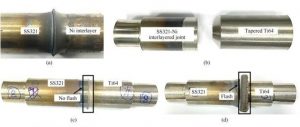
Image: Joints made (a) SS321-Ni interlayer; (b) Modified mating interface; (c) Taper-Flat modified interface geometry; (d) Flat-Flat interface geometry
Image Source: https://doi.org/10.1016/j.dt.2024.12.010
The results were striking. The flat-taper geometry proved highly effective not only at trapping the flash but also at retaining up to five times thicker nickel interlayer compared to the conventional flat-flat joint. The EBSD and EDS analysis of the flat-taper joint showed that the retained, thicker nickel interlayer successfully prevented the intermixing of iron and titanium. This inhibits the formation of the brittle Fe-Ti IMCs that plagued the interface in other scenarios.
The tensile strength of the joints with the flat-taper interface also showed significant improvement. It was, on average, 334.7 MegaPascals (MPa), a remarkable 105% improvement over the 163.3 MPa achieved with the traditional flat-flat interface. Fractography, the study of fractured surfaces, confirmed the reason: the flat-flat joints underwent brittle failure with evidence of Fe-Ti IMC due to intermixing. In contrast, the flat-taper joints failed primarily at the Ni-Ti interface without significant iron presence, indicating the interlayer held firm.
Microstructural analysis of the structure also revealed that the trapped flash within the cavity underwent a phenomenon called dynamic recrystallisation. Under extreme temperatures and pressures, metals can experience dynamic recrystallisation, where their grain structure reorganises or recrystallises into a finer, more random pattern while still hot and deformed. Compared to the standard joint, the new method resulted in significantly finer grains, particularly on the titanium side. The finer grain also contributes to the increased tensile strength of the weld. However, “additional research on deformation strain, strain rates, and process parameter optimisation could further refine the control over recrystallisation and enhance joint performance”, remarks Dr. Mishra.
The study suggests that sometimes, the solution to a stronger connection lies not just in the materials themselves but in the smarter shaping of the space between them. While this study focused on a specific steel-titanium-nickel combination and peripheral properties, the principle of using interface geometry or changing the shape to control flash and interlayer behaviour offers a promising avenue for optimising friction welds in various material systems.
“The technique needs to be extended to other dissimilar material combinations. Further, there is a need to develop models that capture the combined influence of taper angle, interlayer thickness, and process parameters on joint performance,” concludes Prof Shrivastava about the following steps to improve the research.
**********************************************************
The original academic article titled Interface Geometry Modification to Trap Plasticized Flash for Improved Joint Strength Of Dissimilar Rotary Friction Welds was written by IIT Bombay’s researchers and published in the journal Defence Technology, Volume 46.
The original paper can be found here.
4. Understanding Impaired Processing of Reward and Motivation in Parkinson’s Disease

Image Credit : Gubbi Labs
The following article was originally written by Ms. Divyapriya Chandrasekaran and published here.
A data-driven approach to study the mechanisms underlying altered reward processing in individuals with Parkinson’s Disease.
‘Parkinson’s disease’ (PD) is a neurodegenerative disorder mainly affecting the central nervous system. In 2020, more than 10 million people worldwide were living with Parkinson’s disease, and 10% of affected individuals were in India. Patients with PD show symptoms including shaky limbs, muscle stiffness, and slow movements. While these movement-related symptoms are visibly apparent, individuals with PD also manifest other symptoms that are not related to movement (non-motor), such as lack of motivation or disability in experiencing pleasure, attributed to a lack of dopamine hormone. Commonly known as the ‘feel-good’ hormone, dopamine is generally produced when performing a pleasurable task or receiving a reward.
The ability to appreciate pleasure and rewards is a fundamental aspect of human well-being and quality of life. Dopamine provides a pleasurable sensation, motivating one to seek more of the sensation or repeat the rewarding behaviour. Lack of dopamine in individuals with PD leads to altered brain activity and impaired reward processing – the brain’s ability to recognise, value, and respond to rewarding stimuli.
In their recent study, researchers from the Human Motor Neurophysiology and Neuromodulation Lab, Department of Biosciences and Bioengineering at the Indian Institute of Technology Bombay (IIT Bombay) used brain signals to investigate reward processing in individuals with PD.
“In PD, motor symptoms like stiffness and tremors are typically the first noticeable signs, while the non-motor symptoms, including cognitive and emotional changes, often emerge years earlier. Some patients experience cognitive or emotional changes early on, while others may develop them much later, making it difficult to establish a consistent sequence of symptom onset,” remarks Prof. Nivethida, who led the study.
Brain cells (neurons) communicate with each other through electrical signals. Electroencephalography (EEG) measures the electrical activity in the brain using small metal discs placed on the scalp. When an individual performs a certain task, EEG detects changes in the electrical activity pattern of the brain regions that are involved in the task. In this study, the researchers analysed EEG data recorded from 28 PD patients and 28 healthy individuals while they performed a reward-based learning task. EEG was recorded from PD patients both before (OFF condition – 15 hours after their last dose) and after taking dopamine medication (ON condition). Comparing these conditions allowed researchers to understand the influence of dopamine medication on reward processing.
The researchers then used three different analysis methods to understand the brain activity linked to reward processing. First, they used Event-related Potential (ERP) analysis, which computes the brain’s response to a specific sensory, cognitive, or motor event. They found that 250-500 milliseconds after receiving a reward, the ERP from the front part of the brain generally shows a positive response, a phenomenon called reward positivity (a positive waveform response on EEG linked to a reward). Reward positivity is essential for cognitive processes like attention, learning, and emotional responses.
Next, the researchers used time-frequency analysis, which identifies the periodicity or rhythm in the brain activity. They identified slower brainwaves or theta waves with frequencies between 5-7 Hz and faster brainwaves or gamma waves with frequencies between 30-55 Hz, each associated with distinct cognitive states or brain activity. Theta waves are linked to reward processing and creativity, while gamma waves are associated with decision-making and problem-solving. Finally, they measured the level of synchronisation between the theta and gamma waves using a method called phase-amplitude coupling (PAC), which is thought to underlie communication between brain regions. Theta-gamma coupling or synchronisation is crucial for cognitive functions such as reward processing and goal-oriented behaviour.
The results of this study show that reward positivity, as seen in the ERPs, was weaker in PD patients, indicating that their brains do not process rewards effectively. Further, dopamine medication failed to restore the reward positivity. “Normally, the brain releases dopamine as short bursts following a reward, but in PD, these bursts are weaker. Although dopamine medication replenishes the dopamine levels in the brain, it does not produce burst-like signals that mimic the natural process. This could be the reason why dopamine is able to improve motor symptoms but not cognitive functions like reward processing. Hence, adjunct treatment strategies may be required to restore cognitive impairments in PD,” adds Prof. Nivethida.
The results of the time-frequency analysis reveal that while healthy people show reward processing wave activity after receiving a reward, PD patients show weaker corresponding signals in both ON and OFF conditions. This indicates that PD individuals have less reward sensitivity, even with dopamine medication. “These results also suggest that reward processing mediated by theta activity may not be driven purely by dopaminergic mechanisms and that the role of other chemicals in the brain (neurotransmitters) should not be ignored,” says Prof. Nivethida.
The results of PAC analysis indicate that PD patients have weaker theta-gamma synchronisation, resulting in poor communication between brain regions that process reward information and use it for learning goal-directed behaviour. This could be the reason behind the lack of motivation and impaired decision-making in PD patients. Dopamine medication was able to partially restore theta-gamma synchronisation. This finding highlights theta-gamma coupling as a potential biomarker to identify the impairment of reward mechanisms in PD.
“Reward processing deficits are not only reported in PD. They are also observed in other neuropsychiatric conditions such as depression, schizophrenia, and other movement disorders. This overlap complicates its use as a specific early biomarker for PD without additional supporting evidence,” suggests Prof. Nivethida.
Additionally, the researchers report that patients showed higher levels of faster gamma activity in the back part of the brain than healthy individuals and that those with longer disease duration had higher gamma activity. It indicates that this gamma activity pattern could be linked to the disease process in itself and not linked to reward processing. Overall, the study highlights the role of disrupted brain activity patterns in PD patients and how they impact specific cognitive functions such as reward processing.
The IIT Bombay study clearly highlights the connection between atypical brain activity and the impaired ability of PD patients to appreciate rewards, in addition to delving into understanding reward processing in our daily lives. It offers valuable insights into the complex neural mechanisms underlying PD and emphasises the need for adjunct treatment approaches, such as noninvasive brain stimulation, for improving non-motor symptoms in individuals with PD. Notably, it sheds light on how maintaining optimal levels of motivation through reward processing contributes to the quality of our lives.
**********************************************************
The original academic article titled Theta-Gamma Decoupling – A Neurophysiological Marker of Impaired Reward Processing in Parkinson’s Disease was written by IIT Bombay’s researchers and published in PubMed.
The original paper can be found here.

